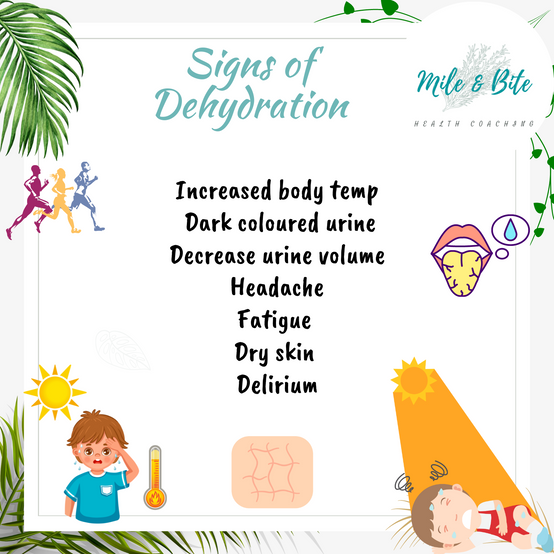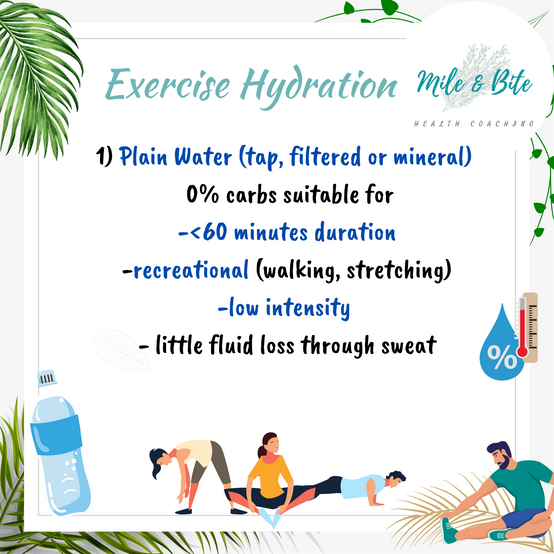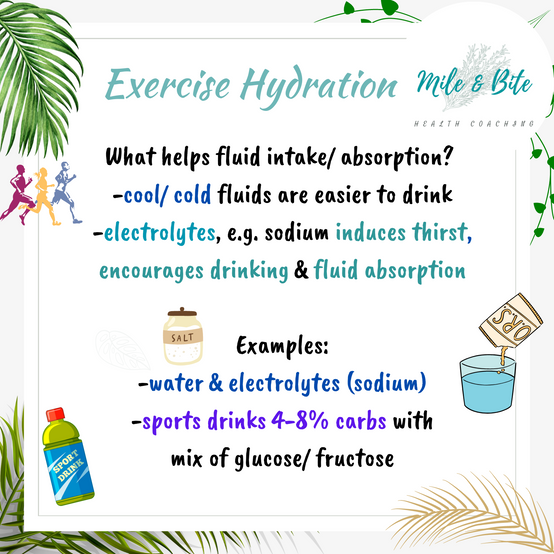Hydration for Endurance Runners - Part 1
- Vicky Sham

- Jun 7, 2023
- 8 min read
Updated: Jun 14, 2023
As an endurance runner, staying hydrated during outdoor workouts is crucial, especially as temperatures and humidity rise. In this post, we will explore signs of dehydration, how fluid requirement changes, what to drink for different workouts, factors affecting fluid absorption and how to avoid issues such as bloating and stomach pains.
If you want to take your hydration strategy to the next level, check out the next blog on how to measure your sweat rate and hydration strategies with specific volumes of fluids for pre-during and post run.

For those who have run with me or seen me running under the summer heat and humidity, you know I totally live up to my sobriquet as the Sweaty Queen Victoria of Hong Kong. This is precisely why I have spent a lot of time and effort researching, reading, learning, and perennially testing different hydration strategies. Of course, it is always work in progress and I’ll share what I know and hope you can avoid some common mistakes as you continue to optimise your performance and wellbeing.
Some Fun Facts
Did you know that for every litre of fluid loss, your body temperature can increase by 0.3°C? Dehydration can also lead to reduced concentration, strength, and muscle fatigue, which can negatively impact your performance.
Exercising intensely in temperatures between 31-32°C can cause a body fluid loss of about 2% of your body weight. Dehydration of more than 2-3% of pre-exercise body weight may impair aerobic exercise and cognitive performance. This makes it even more crucial to stay hydrated when running in hot weather.
Have you ever experienced dehydration or heat stroke during your runs? If you've ever run outdoors during the summer in Hong Kong, you might have experienced some signs of dehydration, such as thirst, dry skin, dark-coloured urine, decreased urine volume, headache, dizziness, fatigue, and delirium. These symptoms can impact both your athletic performance and mental focus.
By being aware of the signs of dehydration, you can protect your body from unnecessary damage and ensure that you perform at your best.
Your Fluid Replacement Rate Can Vary Widely
What to Drink During Exercise?
Why Do Ultra Runners Drink Cola?
Fluid Replacement Rates Vary Widely
The amount of fluid you should consume during exercise varies widely depending on factors such as your fitness level, age, workout type, exercise intensity, exercise duration, and environmental conditions such as temperature, humidity, and altitude.
As a general guideline, slower runners may need around 330ml of fluid per hour, while faster runners may require up to 2 litres per hour. However, the upper limit may be unrealistic for practical reasons, and individual fluid needs can vary significantly based on sweat rate and environmental conditions.
To avoid discomfort and bloating, it's best to take small sips of fluid regularly throughout your run. This can help prevent fluid sloshing in the abdomen and helps fluid absorption.
While it's essential to replace the fluids you lose through sweat and the GI tract, over drinking can lead to a hyponatremia, a condition characterised by low blood sodium levels. Symptoms include nausea, headache, confusion and even coma. To prevent hyponatremia, it is important to monitor your urine colour, which should be pale yellow, and make sure your hydration strategy includes electrolytes like sodium, magnesium, potassium, and calcium to help maintain electrolyte balance.
What to Drink During Exercise?
Choosing the right drink for exercise hydration can be challenging, as there are many options available on the market. Below are a few main groups, each with its pros and cons and suitability for different types of workouts.
1) Filtered or mineral water with 0% carbs is suitable for workouts lasting less than 1 hour and recreational exercises like stretching and walking. Water alone is sufficient for low to moderate intensity, although it may not stimulate thirst like sports drinks.
2) Water with electrolytes and 0% carbs is suitable for moderate workouts lasting around one hour, relevant in hot and humid conditions, and for replenishing fluid and electrolyte loss through sweating or the gastrointestinal system. Electrolytes such as sodium can help fluid absorption.
3) Sports drinks with electrolytes and 4-8% carbs are suitable for exercises lasting over 90 minutes, or high-intensity workouts lasting around 60 minutes. They are designed to replace water, electrolytes, and energy simultaneously. Sports drinks are more palatable than plain water, and more likely to induce thirst to encourage drinking and fluid uptake. They also reduce urine loss and risk of dehydration. Sports drinks typically contain a mix of glucose and fructose at 4-8% concentration to provide energy and help with electrolyte and fluid balance.
4) Energy drinks with 10-12% carbs containing extra supplements e.g. caffeine, taurine, guarana, B complex, etc., are generally not recommended for hard, fast and intense races. Due to the presence of caffeine and taurine, they are unsuitable for children, pregnant women and people allergic to caffeine. The high sugar concentration may slow down gastric emptying and cause GI issues. They may be ok for specific training or trained individuals with specific requirements.
5) Soft drinks and fruit juices are not recommended for short, hard & fast races due to their high sugar and solute content, which can slow down gastric emptying and may cause GI problems. However, exceptions exist for ultra-athletes who have specially trained stomachs that can tolerate and make use of these sugary drinks to meet specific nutrition and energy requirements. See next section.
Why Do Ultra Runners Drink Cola?
Ultra-runners often consume soft drinks like Coca Cola during races to provide a quick source of energy in the form of carbohydrates and caffeine. Although consuming large amounts of sugary drinks can cause stomach issues for some people, ultra runners are able to tolerate them because of several factors.
Ultra runners usually have highly trained gastrointestinal systems that are able to process large amounts of food and fluids during exercise. This means that their stomachs are better equipped to handle high volumes of fluids, including sugary drinks.
Furthermore, the high carbohydrate content of these drinks can be beneficial for endurance athletes who need to maintain their energy levels over long periods of time. The rapid absorption of carbohydrates from sugary drinks can help replenish glycogen stores in their muscles, which can become depleted during prolonged exercise.
However, it's worth noting that consuming too much sugar can have negative health effects, such as weight gain, greater risk of diabetes and other chronic diseases. While sugary drinks can be beneficial for ultra runners during their races, it's important to consume them in moderation and balance with other sources of nutrition.
Absorption Matters
Proper fluid absorption is a key aspect of hydration and can be impacted by several factors beyond the amount of fluid intake. If you are a runner prone to bloating, stomach pains and other gastrointestinal (GI) issues, you may have some food intolerances or difficulties with fluid absorption.
Fluid absorption occurs in the small intestine, where water and nutrients are absorbed into the blood stream. Inflammation or damage to the lining of the small intestines, which is common amongst runners, can affect fluid absorption and cause symptoms such as bloating and stomach pain.
Over hydration, drinking too quickly, and consuming fizzy drinks can exacerbate bloating and discomfort. When combined with the sloshing and swirling of stomach contents induced by running, it can make it even harder for the body to absorb the excess fluid. This is a highly undesirable situation during a race, where the body remains dehydrated while the additional problem of abdominal bloating and discomfort persist.
If you experience chronic bloating, stomach pains and GI issues, it is worth speaking with a doctor to identify the cause of your symptoms and manage them with care.
So, what affects fluid absorption?
Fluid absorption is a key factor to consider when it comes to exercise hydration. Here are some factors to consider:
Temperature: Cool or cold fluids are easier to drink during exercise. Athletes will likely increase fluid intake and also absorption.
Electrolytes: electrolytes like sodium can induce thirst, encourage more fluid intake and aid fluid absorption. Hydration tablets containing electrolytes, and sports drinks with electrolytes and 4-8% carbs, are often more helpful than plain water alone.
Sugar Concentration: A small amount of sugar can help fluid absorption, e.g., sports drinks with 4-8% carbs, either glucose or a combination of glucose and fructose, can be effective at achieving electrolyte and fluid balance.
On the contrary, fluid absorption can slow down significantly when there is too much sugar for example, more than 8% glucose or more than 3% fructose. Excess sugar can worsen dehydration by pulling water from the cells and may lead to increase urination. Similarly, having too much fat or protein in the gastrointestinal system can also negatively impact fluid absorption.
Read the Label and Test Your Drinks
When choosing a sports drink, it’s important to read the nutrition label and ingredients to ensure it meets your individual needs and goals. It is also a good idea to try different drinks during you training runs to figure out which one works best for you. Remember to avoid over-drinking to prevent hyponatremia and aim for a pale-yellow urine colour to ensure you are adequately hydrated.
Below are a few additional factors to consider when choosing your hydration:
Personal taste: choose drinks that you enjoy and find easy to drink.
Cost and availability: pick something that fits your budget and is readily available.
Medication: consider your health conditions, medication and supplements you are taking that may affect your fluid or electrolyte balance
Sweat Rates: Sweat rates can help determine your fluid needs, electrolyte needs, and energy needs under different workout conditions.
Let's Get Sweaty

Knowing your sweat rate can help you develop a personalised hydration plan to protect yourself from dehydration and to optimise your performance.
In the next post, we will discuss how to measure sweat rate and specific hydration strategies for your training runs and races. Stay tuned!
Health Coaching
If you want to know more about healthy eating and healthy running, get in touch for a consultation. I can help you incorporate one little healthy habit at a time and stay healthy as you build up your speed and mileage. You may also sign up to a FREE self-guided health coaching guide here!

Giveaway: Hydrating Recipe
Here is my little thank you gift for your reading right to the end. This spicy tangy watermelon salad is packed with water and electrolytes, perfect for your summer hydration. Click for here for a free recipe.
#mileandbite #healthcoaching #hydrationtips #workouthdyration #electrolytes #stayhydrated #sportsdrinks #endurancetraining #runnershydration #drinkmorewater #trailrunnershydration #marathonhydration #fitnessblog #healthblog
References:
1. Goulet E. D. (2012). Dehydration and endurance performance in competitive athletes. Nutrition reviews, 70 Suppl 2, S132–S136. https://doi.org/10.1111/j.1753-4887.2012.00530.
2. Armstrong L. E. (2021). Rehydration during Endurance Exercise: Challenges, Research, Options, Methods. Nutrients, 13(3), 887. https://doi.org/10.3390/nu13030887
3. Knechtle, B., Chlíbková, D., Papadopoulou, S., Mantzorou, M., Rosemann, T., & Nikolaidis, P. T. (2019). Exercise-Associated Hyponatremia in Endurance and Ultra-Endurance Performance-Aspects of Sex, Race Location, Ambient Temperature, Sports Discipline, and Length of Performance: A Narrative Review. Medicina (Kaunas, Lithuania), 55(9), 537. https://doi.org/10.3390/medicina55090537
4. Klingert, M., Nikolaidis, P. T., Weiss, K., Thuany, M., Chlíbková, D., & Knechtle, B. (2022). Exercise-Associated Hyponatremia in Marathon Runners. Journal of clinical medicine, 11(22), 6775. https://doi.org/10.3390/jcm11226775
5. Cheuvront, S. N., & Kenefick, R. W. (2014). Dehydration: physiology, assessment, and performance effects. Comprehensive Physiology, 4(1), 257–285. https://doi.org/10.1002/cphy.c130017
6. Thomas DT et al. Position of the Academy of Nutrition and Dietetics, Dietitians of Canada, and the American College of Sports Medicine: Nutrition and Athletic Performance. Journal of Academy of Nutrition & Dietetics. 2016; 116: 1 – 28.
7. Tiller, N. B., Roberts, J. D., Beasley, L., Chapman, S., Pinto, J. M., Smith, L., Wiffin, M., Russell, M., Sparks, S. A., Duckworth, L., O'Hara, J., Sutton, L., Antonio, J., Willoughby, D. S., Tarpey, M. D., Smith-Ryan, A. E., Ormsbee, M. J., Astorino, T. A., Kreider, R. B., McGinnis, G. R., … Bannock, L. (2019). International Society of Sports Nutrition Position Stand: nutritional considerations for single-stage ultra-marathon training and racing. Journal of the International Society of Sports Nutrition, 16(1), 50. https://doi.org/10.1186/s12970-019-0312-9



















































Comments